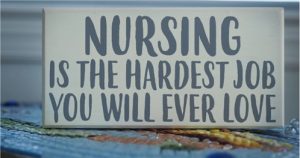The Exodus: How COVID Traumatized a Generation of Nurses
 Tiffany Busby remembers the little details. Names. Faces. The eerie whoosh of the ventilators. The sobs of family members on video calls. Her goggles fogging up and filling with her own tears.
Tiffany Busby remembers the little details. Names. Faces. The eerie whoosh of the ventilators. The sobs of family members on video calls. Her goggles fogging up and filling with her own tears.
There were so many patients, the former intensive care nurse says, so many tortured COVID cases. She cared for them until their final breaths, playing both caregiver and loved one as visitors were barred from their bedsides.
Then in June 2021, Busby’s heart began to race. A colleague told her she looked ill. Her face went white.
The panic was creeping in again.
Busby, 39, tried to stand near the nurses’ station. Darkness suddenly enveloped her. She keeled over, passing out.
It was her last shift in the ICU at Jersey Shore University Medical Center in Neptune.
“After a year and a half of watching people die, I couldn’t do it anymore,” she told NJ Advance Media.
They stay with her. The faces of dying patients.
“I took them all home with me,” the blonde-haired, blue-eyed mother of three said in a somber, gentle voice.
More than two years into the pandemic, those faces still haunt the former ICU nurse.
She’s hardly alone in an industry in crisis.
Nurses across New Jersey were walloped when the pandemic arrived, swept up in a vortex of death and trauma and grief. Witnessing death is part of the job. But the crushing flood of critically ill patients was something new and catastrophic — even for the most seasoned of nurses.
The images remain hard to shake. The strain of 2020 and 2021 changed the lives of many health care workers. And in some cases, so did the decisions of their bosses and the hospitals that employ them, testing their faith in those institutions.
Everyone wants to forget. But they can’t, even as the public has largely moved on from the pandemic.
So nurses are leaving emergency care. Leaving hospitals. Leaving the profession altogether.
About 100,000 U.S. nurses abandoned the job in 2021, the largest exodus in four decades, according to an analysis in the journal Health Affairs. The nursing workforce plummeted 1.8% between 2019 and 2021 due to COVID burnout, early retirements and increased stress from existing staffing shortages exacerbated by the pandemic.
Worse, young nurses are disproportionately leaving the field. The number of U.S. nurses under 35 fell by 4% over that period.
“They are not staying at the bedside for more than two years, if that, and the experienced nurses have left,” said Kathleen Burke, assistant dean of nursing programs at Ramapo College. “And that’s a gaping hole.”
Why should you care? Because when you or a loved one are in a car accident or suffer a heart attack, nurses are the people caring for you. And soon, there may not be enough of them, health industry experts warn.
For many nurses, the scars and memories of the past 29 months have become too much to bear. The pandemic seems interminable, a trauma that just won’t end.
There was no time to pause and process the horror and the anger and the frustration in the thick of the initial wave, experts say. That alone was enough to leave them with post-traumatic stress disorder. But then came the second surge in the fall and winter of 2020. Then delta. Then omicron. Crisis after crisis. Variant after variant.
The exhaustion built. The burnout soared.
“You just kind of internalize it and try to move on,” said Sheryl Mount, 59, a long-time registered nurse at Virtua Mount Holly.
But you never get over it, she said.
It will never leave you.
Lasting scars
Many nurses say the industry is in shambles.
The profession was rife with challenges even before the pandemic. Overwhelming workloads. Unyielding stress. Plummeting morale.
But preeminent among those challenges is a staffing shortage years in the making.
Nursing “is in crisis,” Burke said, and facing “a huge turning point.”
“You look at their mental health, their levels of depression, their stress, their PTSD — it’s dramatically high,” she added.
New Jersey will face one of the most acute nursing shortages in the nation by 2030, according to an estimate by the U.S. Department of Health and Human Services.
The vacancy rate for registered nurses in Garden State hospitals — the percentage of unfilled positions — jumped to 13.4% last year, according to a February survey by the New Jersey Hospital Association.
To make up for the shortfall, hospitals spent about $500 million on overtime in 2020 and $592 million in 2021, the NJHA found. They also shelled out $222 million on travel and agency workers in 2020 and were projected to spend another $670 million in 2021.
Many nurses are just hanging on, coping with burnout and trauma while forced to pull extra shifts or longer hours to make up for limited staffing.
Some have cried in their cars after work. Others have endured sleepless nights. And many have sought therapy or questioned their calling to care for the sick.
Pushed to the brink, 90% of U.S. nurses are considering leaving the profession in the next year, according to a November survey of hospital nurses by Hospital IQ, a predictive analytics company.
“What’s happened with COVID has really put such a strain on the nursing workforce that they’re having a hard time reconciling that,” said Edna Cadmus, a clinical professor at the Rutgers School of Nursing and executive director of the New Jersey Collaborating Center for Nursing.
They are health care workers like Dr. Lindsay Fox, an emergency doctor who worked at Rutgers New Jersey Medical School in Newark.
She witnessed thousands of COVID-19 patients desperate for help. Each day, she passed a refrigerated truck full of bodies.
By October 2020, it all became too much.
She retreated to New Mexico “to heal my grief,” she wrote in an Instagram post.
NJ Advance Media reached out to Fox and three nurses who left the health care industry due to the pandemic. They either declined interview requests or did not return messages.
Of course, the dire situation in hospitals has calmed since the dystopian spring of 2020. Vaccines have helped. So have effective COVID-19 treatments. And nurses no longer live in terror that they might bring the virus home with them.
But there are lasting scars that must be confronted.
The omicron wave that washed over New Jersey like a tsunami in December and January reopened old wounds, just another reminder that the pandemic is not over.
“My biggest fear now is really how do we move forward and get people to love nursing again and stay at the bedside to take care of patients?” Mount said.
A particularly chaotic evening shift in April 2020 still weighs on Fredrick Apostadero, 31, a registered nurse at St. Joseph’s University Medical Center in Paterson. Patients were pouring in unlike anything he had ever seen. There was a nurse in tears after a young patient had just died.
He took her into his office.
“She’s like, ‘We’ve done everything that we could for this patient, but it was so fast,’” Apostadero said.
Some nurses buried the pain. There was too much to do. Too many other people to care for.
Wendy Lamparelli, 55, a nursing supervisor at St. Joseph’s Wayne Hospital, lost her mother-in-law to COVID-19 in 2020.
“Even though there were moments where I definitely felt extremely burdened, heavy, traumatized … based on the volume of death that we were seeing initially,” she said, “I really have not had the ability to stay in that place emotionally for too long because I just have too many people depending on me.”
Mount doesn’t feel the anguish at work. It hits her at home.
There the insidious doubt creeps in.
“When you’re alone at home, you kind of go through your day and say, ‘You know, I could’ve done this better. I could have done that better,’” said Mount, who works in the post-anesthesia care unit but had shifted to the ICU in the early days of the pandemic when it was all hands on deck.
How does she reconcile it?
“You try to push it down,” she said, “because it’s almost unbearable.”
Michele Acito also witnessed her mother-in-law die of COVID-19 — in the very hospital in which Acito works.
The chief nursing officer at Holy Name medical center was devastated. But nurses have to keep going.
Ten patients poured into the Teaneck hospital’s emergency room every half hour at the pandemic’s peak, she said.
Yes, the deaths were wrenching. But it was the onslaught of critically ill patients, the barrage of people struggling to breathe and with panic in their eyes that got to Acito.
Her voice remained measured and composed as she spoke, but hints of emotion occasionally seeped through. A little anxiety here. Some exasperation there. Yet her sober descriptions conveyed most of the horror.
“So many patients on ventilators,” she said. “Our average daily census of ventilators pre-pandemic was between five and seven. And at the peak, we had 48.”
Some nurses were brought in from other departments. Inexperienced in critical care, they relied on veteran nurses to guide them as gasping patients cascaded through the door.
It was chaos.
The inexperienced were “paired with intensive care nurses so that those nurses could be stretched to the nth degree…” Acito explained. “It seemed like every time you were able to get someone out of the ER, three more came in.
“Every time you took somebody off the ventilator, four more went on a ventilator.”
She compared the deluge to “treading water in the middle of the ocean.”
“It was a very overwhelming feeling,” Acito said. “It was a feeling of: ‘Am I going to lose my breath? Am I going to drown in this?’”
Institutional trauma
Some nurses trace their trauma to their hospital, not the coronavirus.
They say their own health systems let them down. That they didn’t protect them well enough. That they prioritized money and public relations over patient care and staff safety.
Fighting the pandemic was grueling enough. Fighting your employer while engulfed in a historic public health crisis was a crucible of anxiety and pressure.
Hospitals across the state faced a shortage of face masks, gloves and hand soap, especially in the spring of 2020. There were not enough ventilators. Some health workers were forced to reuse masks, and the masks they did have were sometimes faulty or counterfeit.
Several hospitals petitioned national and state officials for help. Some reached out to the community. But others seemed to deny they needed assistance, some nurses say, fearful of harming their reputations even as those supplies ran dangerously low.
Adam Witt, a nurse at Jersey Shore University Medical Center, was fired early in the pandemic for speaking out about a shortage of personal protective equipment, he says. Before he was terminated, he reached out to politicians and community leaders to alert them of the need for PPE.
A state representative gave him some shocking news.
“I was trying to get them to understand what was going on as far as PPE and things like that. He told me, ‘Well, we were on a phone call with the hospitals the other day and they said everything is fine,’” said Witt, a leader in the Health Professionals and Allied Employees union. His job at Jersey Shore University Medical Center was later reinstated by an arbitrator. “I was just like, ‘You guys are not listening to the right people.’”
Busby said she and others also spoke out about suspect respirators and other PPE issues. Despite several complaints to her supervisor and the HPAE, nothing was done to fix the problem, she said.
After an investigation, the U.S. Occupational Safety and Health Administration alerted the hospital that some masks were indeed probably counterfeit. It also fined the medical center $23,133 for failing to evaluate staff who reported signs of illness and for not performing respirator fit-tests. Hackensack Meridian Health is contesting the case.
In a statement, Hackensack Meridian Health — Jersey Shore University’s parent company — said in part: “The priority of Hackensack Meridian Health is the safety of our patients and team members. Our leadership teams sourced the globe for vital Personal Protective Equipment (PPE) early in the pandemic to ensure adequate supplies.
“Through our network command center, which operated 24/7 in various stages of the pandemic, we effectively marshaled gowns, N-95 respirators, eye protection, gloves and more throughout the network as needed.”
All these months later, nurses are trying to move on from the reservoir of anger, stress and resentment.
Many hospitals have attempted to ease their workers’ anguish. They have offered mental health and wellness programs, peer support groups and virtual exercise activities. But some nurses have rejected services implemented at the very source of their stress, while others fear expressing burnout or anxiety in employer-sponsored settings.
The HPAE, a union that represents 14,000 nurses and other frontline health care workers, offered free virtual workshops this spring through a partnership with the American Federation of Teachers and the Mental Health Association in New Jersey.
Meanwhile, the New Jersey Nursing Emotional Well-being Institute (NJ-NEW) — an organization formed earlier this year — is also trying to help nurses with burnout, anxiety and PTSD. Nurses can talk online, share their stories in a safe space and find peer support. The organization is supported by The Robert Wood Johnson Foundation, which provided a one-year grant.
“Nurses were challenged with unrealistic workloads; insufficient resources and protective equipment; risk of infection; stigma directed at health care workers; and the mental, emotional, and moral burdens of caring for patients in the face of a new, unpredictable disease,” NJ-NEW Assistant Director Jennifer Polakowski said in a statement. “All of this has left an imprint on nursing and nurses.”
It’s an indelible stain that meditation, yoga and even therapy might not be able to wash away — at least, not quickly.
“We’re used to saving — not everybody — but most people,” said Busby, a Marlboro resident who worked in the ICU for five years. “And in 2020, that just wasn’t happening.
“Everyone was dying. And it was terrifying because we didn’t know what we were dealing with.”
The mere mention of one specific patient still brings her to tears. It was April 2020.
“They were thinking it was going to be OK. (Then it) went really bad, and (they) ended up getting intubated,” said Busby, withholding certain details to preserve the family’s privacy. “I was taking care of that patient that night, and I had just gotten off the phone with the family.”
Her voice trembled.
“And I had told them: ‘Patient’s doing great. Everything’s looking good,’” she said.
Less than 15 minutes later, the patient took a turn for the worse. Busby set up a video call with the family, and she and a respiratory therapist stayed until the life drained from the person’s eyes.
She rubbed the patient’s head and whispered in their ear that everything was going to be OK.
Then she bathed the body.
But there was no time for reflection, for processing the hurt. It was on to the next patient. At the height of the pandemic, Busby’s unit sometimes lost more than 10 people per shift to the coronavirus.
“That’s all we had was COVID,” she said. “Everyone was COVID.”
The onslaught ground her down. The unceasing death filled her days and nights with tears and nightmarish images.
“We would work so hard to save these people’s lives and we would throw so many resources at it, and then it was just — it was done,” Busby said. “And you would look around at everything and wonder: Why couldn’t I save them?”
Busby has been undergoing therapy since COVID first hit. But by June 2021, she was having panic attacks. The anxiety pushed her to the edge.
Then she passed out. She was taken to her own emergency room.
The anxiety, along with a heart condition she didn’t know she had — inappropriate sinus tachycardia — spiked her heart rate and caused her blood pressure to plummet.
In the summer of 2021, she applied for a transfer within the hospital. She now works in cardiac diagnostics.
“I was going home every day crying,” Busby said. “I was crying on the way to work.”
‘How do we move forward?’
Sheryl Mount said it almost reluctantly. But the veteran nurse cannot recommend her profession in good faith.
Not anymore.
“It’s been great for me over the years, but health care right now — and nursing in particular — in my mind, is broken,” Mount said. “So I tell people nursing is broken.”
It seemed painful for her to admit.
Mount worries about the future.
There are 3 million registered nurses in the workforce, according to the U.S. Bureau of Labor Statistics, but demand is expected to jump 7% by 2029.
The shortfall could result in a deficit of 200,000 to 450,000 registered nurses needed for direct patient care by 2025, according to a May report from the consulting firm McKinsey and Company.
“It always comes down to staffing,” said Burke, the Ramapo assistant dean. “And burnout has been a problem in nursing for as long as I can remember. I mean, I did my dissertation on burnout 35 years ago.”
Acito worries about the younger nurses. She spoke about the need to compartmentalize. It’s a common theme among caregivers. They must push their feelings to the background to get the job done, they say.
But emotions burrow.
With Busby, they dug in deep.
She had been studying to get her master’s degree as a nurse practitioner in acute care. But she has changed course, opting for the mental health side of nursing.
If it hadn’t been for the pandemic, Busby would likely still be in the ICU, heart problem or not.
She knows many nurses who have left the field. What will happen to the ones who stay? How will hospitals contend with a massive shortage? Who will fill the vacancies?
Training the next generation of nurses is a top priority, according to Cadmus, the NJCCN executive director. But the industry faces a series of challenges in developing future caregivers.
There is not enough faculty, for starters. Funding is also lacking, often resulting in limitations in virtual reality training and the highly effective simulation mannequins used to prepare students, experts say.
“We know that there is an issue with getting more nurses into school,” Cadmus said. “The pipeline can’t move if we don’t have enough faculty to teach students.”
She points to state Senate Bill 2825, which aims to address a number of ongoing issues in the nursing field, including funding for nursing school faculty and students.
COVID isn’t gone, of course. Another alarming wave could hit in the fall and winter, as the experts predict. And no one knows what the next variant will look like.
No one wants to think about it.
There have been high points, of course, Busby noted. One COVID patient had barely clung to life. They worked hard to save him.
“This is someone who everybody probably thought would die, and he didn’t,” said Busby, the mother of stepson Sean, 22; and daughters Kylie, 19, and Emily, 8.
She’s Facebook friends with the patient to this day.
For the nurses who remain in emergency care, the sense of dread, the feeling that the virus hangs over each day has passed.
“Do people still get admitted? Yes. Do they seem pretty sick when they come in? Yes…” Acito said. “But (we’re) definitely in a much better place, especially with our mental health.”
But COVID still lingers.
“I think we’re in a place now where we realize this is a disease we’ll be caring for for many years to come,” Acito said. “Who knows? Could be for the rest of our own careers.”
The trauma won’t go away either.
Busby talks to her husband, Rob. She leans on other nurses. But she won’t return to the ICU.
“I have a husband who will absolutely listen to me. He helped me every day when I would cry after work,” she said before tears overtook her.
“It’s not just nurses. It’s doctors. It’s respiratory therapists … I mean, all of these people, even the housekeepers. They were here too. We all did the best that we could.”
(This story originally appeared in NJ.com.)




